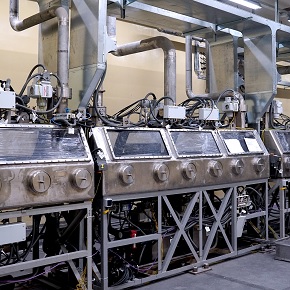 |
||
|
Chinese First Industrial-Use Nuclear Steam Project Comes into Operation in Jiangsu CNNC, PUBLISHED 29.06.2024 According to China Atomic Energy Authority (CAEA), China's first project of producing industrial steam via nuclear power station, "Heqi No. 1", was officially completed and put into operation at Tianwan Nuclear Power Station (TNPS) in Lianyungang city of Jiangsu province on June 19. The station is invested and held by China National Nuclear Power Co., Ltd, a subsidiary of China National Nuclear Corporation (CNNC). The completion of the project marks the evolution of the nation's use of nuclear energy to industrial steam supply from its conventional use in electricity generation and commercial supply of steam for heating homes. The "Heqi No. 1" project, recognized as one of the first batch of green and low-carbon advanced technology demonstration projects, is characterized with its green, safe, stable, and efficient features. The project has used secondary circuit steam generated from the third and fourth reactors, as its heat source. It has adopted multi-layer isolation design among the primary, secondary and steam circuits in the nuclear power station, ensuring physical isolation in the midst of producing industrial steam. The steam is then transported to the petrochemical industrial base through industrial gas pipelines via multi-stage heat exchange, replacing traditional coal consumption and addressing the heat and power needs of petrochemical enterprises. Upon its completion, the project will deliver 4.8 million tons of zero-carbon steam annually from the TNPS to the Lianyungang Petrochemical Industry Base. This is equivalent to reducing the combustion of 400,000 tons of standard coal each year, cutting carbon dioxide emissions by 1.07 million tons, sulfur dioxide by 184 tons, and oxynitride by 263 tons annually. It is also comparable to plant 2,900 hectares of forests each year and save over 700,000 tons of carbon emission quotas for the petrochemical base annually. It has not only opened a new path for the utilization of nuclear energy in pushing for the green development and upgrading of traditional industries but also injected stronger momentum into the high-quality development of the regional economy. Huang Ping, secretary-general of the CAEA, said that in recent years, the CAEA has promoted the comprehensive utilization of nuclear energy and the widespread application of nuclear technology in fields such as industry, agriculture, healthcare, environmental protection, and safety. It has also supported the implementation of several projects related to steam supply for industrial purposes. In the years ahead, the CAEA will continue to nurture and develop a number of nuclear technology utilization and application projects in a drive to build a green, prosperous, healthy, peaceful homeland, facilitate the realization of the country's "dual carbon" goals, and enhance the well-being of the people. Ye Qizhen, an academician of the Chinese Academy of Engineering, said that the integrated utilization of nuclear energy coupled with energy-intensive industries will further highlight the low-carbon values of the nuclear energy, meet the diverse needs of energy-intensive industries, and provide decarbonization solutions to industries with heavy carbon emissions. It will also support the building of large-scale chemical and industrial bases in the country, aligning closely with the country's stratetic plans for the green and low-carbon industrial transformation. Zhang Yi, Party secretary and chairman of Jiangsu Nuclear Power Corporation (JNPC), said that the building of a beautiful country and the improvement of the quality of ecological environment fundamentally rely on accelerating the transition to a green and low-carbon development model. The "Heqi No. 1" project, developed by the JNPC in collaboration with various partners, will serve as a model of clean steam supply for petrochemical industries nationwide and inject new impetus into China's high-quality development. In addition to the utilization of nuclear energy in heating and steam supply, it has been widely used in the fields of isotope production, hydrogen production and seawater desalination. Currently, China's comprehensive nuclear energy utilization has shown a diversified development trend. Additionally, nuclear technology has been widely applied in the fields of industry, agriculture, healthcare, environmental management and public security, leading to the formation of a significant industrial scale and delivering remarkable economic and social benefits. Topics: Asia, China, NPP Tianwan Other news: Six reactors with a capacity of 55 MW each. Main control room of Linglong One put into operation The Linglong One DCS has been built with China's domestically-developed Longlin and Longqi platforms. ROSATOM showcases advanced nuclear technologies and logistical solutions at 8th Russia-China Expo Over the past 25 years, ROSATOM and our Chinese partners have reached a high level of collaboration. Last news:
|
Hero of the day 
The Fabrication/Refabrication Unit is facility of the Pilot Demonstration Energy Complex (PDEC), which is under construction in Seversk under the strategic "Proryv" (or "the Breakthrough" project). INTERVIEW
CNNC OPINION
Han Yongjiang |
Licence Эл №ФС77-30792. ATOMINFO™ trademark.

